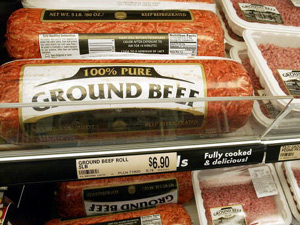|
Audio
Photos
|
March 2, 2005
 |
| U.S. agriculture interests say keeping the U.S. cattle free of disease is critical, especially if ranchers want to be competitive in the global market. (ROBYN BECK/AFP/Getty Images) |
Moorhead, Minn. — If the ban is lifted, Canadian farmers and ranchers will be allowed to sell some cattle in the United States. Only animals 30 months or younger will be allowed in. Processed beef from such animals is already allowed in the U.S.
The Ranchers-Cattlemen Action Legal Fund wants to keep the ban. The advocacy group works on behalf of family farmers and ranchers. Bill Bullard, the chief executive officer of R-CALF, says keeping Canadian cattle out of the U.S. is a health issue. He says it's the only sure way to keep BSE from spreading.
"The best science available suggest that the way to prevent the disease is to have very strict and conservative import standards," says Bullard, "which is precisely why the United States has not detected a case in the United States and why we should continue to maintain those strict standards with respect to Canada."
Bullard says keeping U.S. cattle free of the disease is critical, especially if ranchers want to be competitive in the global market.
"We had 58 of our customers, export customers close their borders to the United States when a Canadian cow was discovered in the United States with this disease," says Bullard.
But some say the ban is hurting America's meat industry. Jeremy Russell, who works for the National Meat Association, a group that represents meat processors and packers, says the import regulations carefully monitor the health of the Canadian cattle.
"You're going to have to bring them in as a group, you're going to have to bring them in under seal, you're going to have to be able to verify that they're under 30 months of age," says Russell. "Then you're going take them directly to a slaughter plant or directly to a feedlot and then they're going to have to be marked individually with tags so that they have full trace back."
Russell says since America closed its border to Canadian cattle, it's had an impact on U.S. packing plants. Russell says jobs have been lost.
"The meat from these animals can come across the border, it's just the animals that can't. We're seeing an increase in capacity in Canada," says Russell. "They're (Canadians} building more plants, they're putting in more lines (workers) on the existing plants and what we'll see is more of our jobs going north of the border."
At the heart of this issue is balancing health concerns with economic vitality. John Lawrence, an agriculture economist at Iowa State University, says it's risky scaring people about the safety of Canadian beef.
"My concern is if we continue to point to Canada and say the product is unsafe, will there come a point where consumers begin to believe it?" says Russell. "And then will they make the connection to say, 'wait a minute! You're not doing anything that they're not.'"
Lawrence says Japan is a good example. According to Lawrence, Japanese officials have hinted they will not lift their ban on U.S. beef unless the U.S. opens its borders to Canada.
No matter what happens on the ban, both sides say the issue will not be resolved. Federal lawmakers from cattle country on both sides of the political aisle are working to extend the ban. They want assurances from Canadian ranchers, the cattle shipped to the U.S. is disease free.




